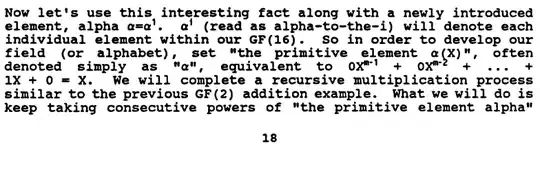I am reading Geisel's tutorial$^{\color{red}{\star}}$ on Reed-Solomon codes, in which a Galois Field is developed. The elements of the field are generated as consecutive powers of $X$, modulo an irreducible, primitive polynomial $F(X)=X^4+X+1$. From pages 18 and 19,
My question is: Why can $X^4\mod F(X) = X^4 + X + 1$ be calculated by '... setting our 4th degree $F(X)$ to zero, and obtain the 4-tuple equivalent to $X^4$.'?
A few pages later, the same modulo function is performed using a long division on the polynomials, which I understand. But why can this also be done as mentioned above?
The answer is probably obvious, I just don't see it.
$\color{red}{\star}$ William A. Geisel, Tutorial on Reed-Solomon Error Correction Coding [PDF], NASA Technical Memorandum 102162, NASA, August 1990.

